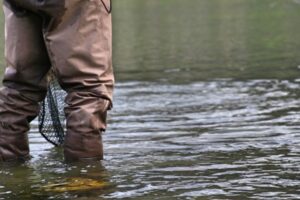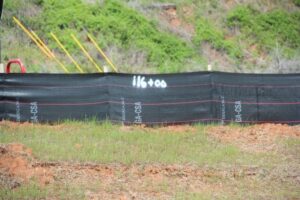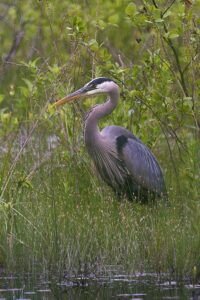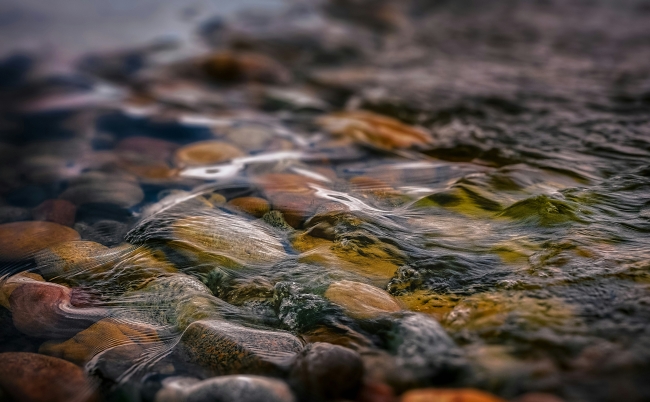The following essay can be found in Arthur Stewart’s exceptional book, Bushido: The Virtues of Rei and Makoto.
I live in a small town, southwest of Knoxville, Tennessee. It is Appalachia, pure and simple, in the Ridge and Valley Province. But the area is urbanizing rapidly now due to its proximity to several key interstate highways. This rapid growth in population means change, and change, in turn, can set the stage for conflict.

It is a hot, still morning in late July. Clouds already are piling up to the west, suggesting the likelihood of an afternoon thunderstorm. I’m with fellow stream ecologist, Mike Ryon; we have a group of seven high school students in tow. I’m in calf-high olive-green rubber boots; Mike and the students are in chest waders. We’re walking now at the edge of an area that has been leveled recently to make a soccer field, not far from the town’s high school. Stripped of its vegetation, the land has been scraped to hard clay. From high in the air, I think, it might look like a very small version of the Great Red Spot on Jupiter: it is that color—red-orange-yellow. Having been leveled, the field lacks natural contour: it is flat; it has no ecological personality. But it is bordered on the north and the east by Town Creek, and Town Creek, this morning, is our destination.

Along the northern edge of the field, near the stream, I show the students how an improperly installed silt curtain fails to prevent silt from running from the field directly into the stream. The black mesh curtain is staked firmly and it looks snug and smug at a distance. But the base of the curtain is not buried even when it was installed. Already there are tell-tale signs of erosion. Here and there, water has cut little gullies into the red clay under the curtain—little places that bleed silt into the stream with even a small rain. Straw bales have been deployed to help prevent the flux of silt into the stream when it rains. These bales also look good at a distance. But they are poorly staked and not properly placed. Most of the bales are non-functional with respect to their intended purpose: they have no chance of intercepting any surface flow at all, even in the event of a hard rain. The students absorb these details; they consider the evidence; they discuss the situation; they express indignation. They do not respect what has been done.
Mike points out various invasive plant species thriving along the stream’s banks—privet, Japanese Grass, Kudzu, Johnson Grass, Japanese Stiltgrass, Japanese Honeysuckle. He explains how invasive plants can out-compete native vegetation, reducing biodiversity and lowering the quality of food and habitat available for wildlife. The students look and listen.
A few dozen meters further, I pause again and point out to the students with a sweeping hand the curve of a large sycamore tree. It leans gracefully over the stream, roots gripping a steep undercut bank. Mike explains how trees and bushes can stabilize stream banks with their roots; I talk about how the canopies of the trees shade the stream, keeping the water cooler. We work our way next through a scruffy zone of ironweed, oxeye daisies and Queen Anne’s lace, then plunge to shade under trees, passing through a smattering of jewelweed, poison ivy and monkey flower. Then, at last, in deep shade, we come to water.
There, Mike points out the main features of stream structure—pools, runs and riffles, all snuggled into the stream channel. These structures are held in place by the interactions of bedrock, the mass of moving water and gravity. We squat in the stream to capture a few snails, find a crawdad, measure the temperature of the water and collect a water sample for laboratory analysis; we turn over a few rocks to see what’s there. Then Mike gets the battery-powered backpack electrofisher fired up. He wades into the pool with the shocker and goes at it, nudging the long-handled probes behind and under fallen limbs, around rocks, boulders and cobbles, nosing them into secret places where stream fish like to hide. He works slowly upstream, through the pool, through a rifle, through the next pool. The students wade in single file behind him. Three make themselves busy netting stunned fish. They put the fish they net into a plastic five-gallon bucket, half-full of water.
Seventy meters or so later, the stream bends hard to the right. We stop there, at the base of a large pool, in the shade of a sycamore. Fish and water in the bucket are poured into a dip-net. The water runs through the net, revealing a wiggling, thrashing collection of fish. Mike sorts them quickly by species, pointing out differences in the position of their mouths, differences in coloration, and differences in body plans. Each fish, an individual: northern hog-suckers, white suckers, stoneroller minnows, striped shiners, bluegill sunfish, blacknose dace, snubnose darters, creek chubs and lots and lots of banded sculpin. Each fish is identified before being released back into the stream. A student tallies the number of fish of each type as they are released. As he works through the fish, Mike explains new terms he uses in describing the catch: “pollution tolerant,” “benthic,” “fusiform” and “omnivorous.” He explains how the various types of fish found here do things differently, and how, although they are individuals, they work together as a community.

Something behind us moves and almost as one we turn to look back. There, two pools downstream, at the bend where we started, a great blue heron has landed. It folds its wings carefully, then stands motionless, staring at us warily from the stream’s edge. The students stop what they are doing. All seven stand motionless, staring back. After a moment they begin talking again, but more quietly. Today we’ve shown them stream Bushido: form and function; attention to detail; individuals, communities; respect the water, honor the land. We’ve done what we can with this little group of Appalachian high school students. Five years from now, or ten years perhaps, after they’ve settled down and become productive individual members of society, they may remember how to take care of a stream.
Arthur Stewart’s poems have been published in national and regional anthologies and in various literary and scientific magazines, including Rattle, Journal of the American Medical Association, Lullwater Review, Big Muddy, New Millennium Writings, and Chemical & Engineering News. He was a 1997 Tennessee Poetry Prize winner, a 2009 winner of the Wilma Dykeman Prize for essay writing, and a 2013 inductee into the East Tennessee Writers’ Hall of Fame for poetry. He has given science writing workshops for undergraduate, graduate, and postgraduate science interns at U.S. Department of Energy facilities in Tennessee, West Virginia, Pennsylvania, South Carolina, Oregon and Colorado.
Click the following images to find more of Arthur J. Stewart’s writing:
**Featured image Robert Zunikoff, Unsplash





















Mr. Stewart is a wonderful writer, whether essay or poetry. Thank you for posting this essay.